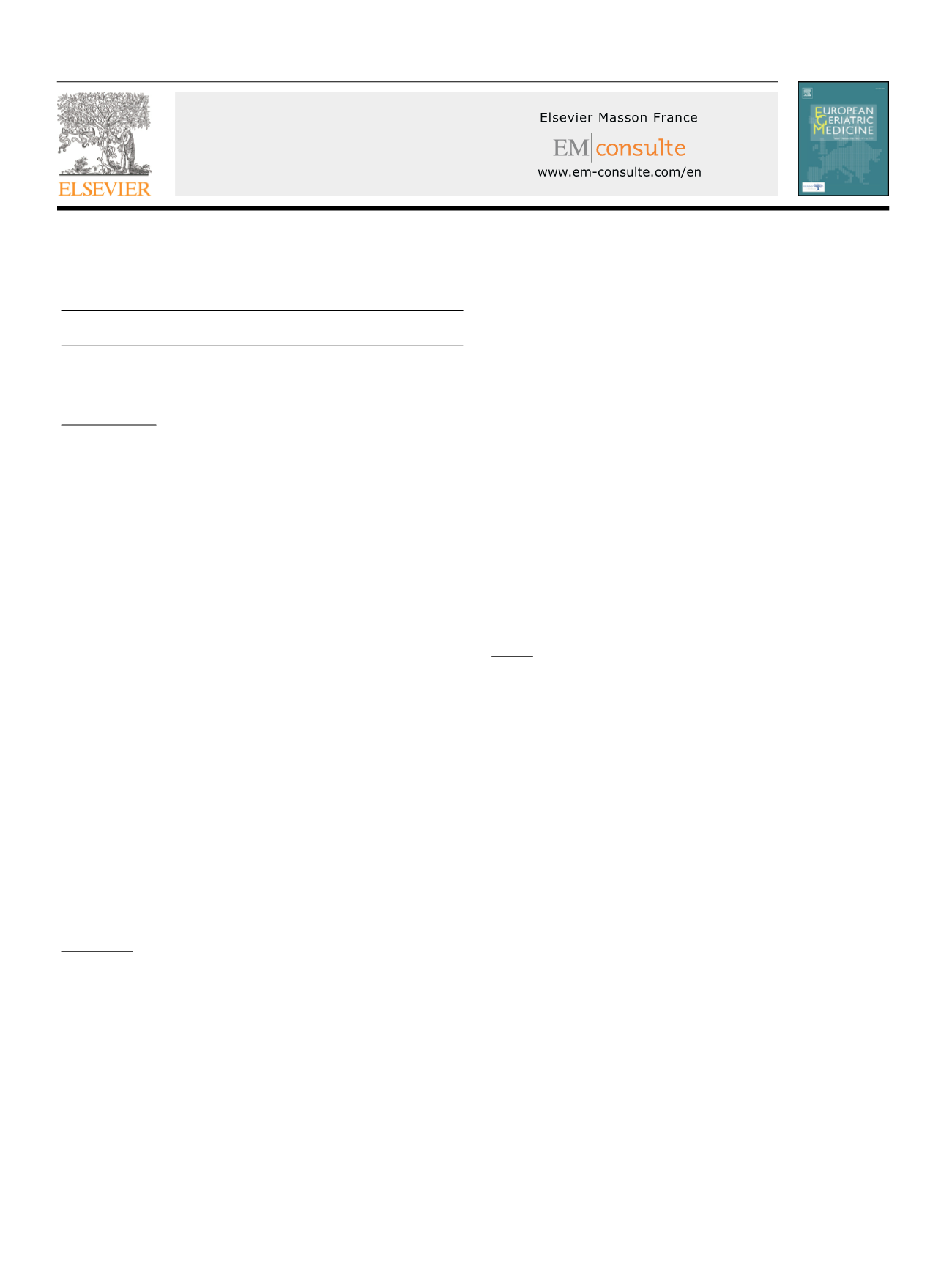

European Geriatric Medicine 6S1 (2015) S32–S156
Available
online
at
ScienceDirect
www.sciencedirect.comPoster presentations
Acute care
P-001
Increased mortality in a Norwegian nursing home after
implementation of the Coordination reform
J.F. Abrahamsen
Storetveit Nursing homeMunicipality of Bergen and Kavli
forskningssenter for Geriatri og Demens, HDS, Bergen, Norway
Objectives:
The Coordination Reform (CoR) was implemented in
Norway January 2012 with a major aim to treat more elderly
patients in their local community. However, there has been concern
that older patients, as a result of this, are discharged too early from
the hospitals, and that more patients die after transfer to short-
time nursing homes (STNH). Our aim was to compare mortality
in patients admitted from hospital to a STNH, before and after
implementation of the Coordination reform.
Methods:
This was a retrospective study from a single 35 bed
nursing home ward that received patients from the two hospitals in
Bergen. Home-dwelling patients aged ≥70 years transferred before
(n= 186) and after (n = 177) the Co R were included and compared.
Results:
The patients that were transferred from hospital after
implementation of the CoR were older, median 88 compared to
85 years, p
<
0.001 and more patients died after transferal to the
nursing home; 27% versus 13% of the patients, p = 0.002. Median
number of days in the nursing home before death were 14 days
after, and 12 days before the CoR (n.s).
Conclusion:
The present study, though limited in size and
from a single institution, support the concern that after the
implementation of the Co R, more elderly patients die after
transferal to STNH during the initial period. This may imply both
a higher patient turnover and increased demand for nurses and
doctors to spend more time with patients and their families
concerning end of life decisions and care.
P-002
Medical admissions through the emergency department:
Who, how and how long?
P. Arvidsen
1
, E. Pressel
2
1
Department of geriatric medicine, Bispebjerg Hospital, University
of Copenhagen, Copenhagen, Denmark;
2
Medical doctor, Bispebjerg
Hospital, København NV, Denmark
Objectives:
The study aims to describe the clinical characteristics of
elderly patients admitted to medical wards through the emergency
department (ED).
Methods:
In a first part, we described demographic changes in the
uptake area and ED visits of older patients in a 900 bed university
hospital in Central Copenhagen from 2004–2014.
In a second descriptive-retrospective part we studied clinical
characteristics of patients
>
65 years admitted to the medical
wards through the ED in january 2014 (n = 132). We collected data
on presenting symptoms at admission, medication, comorbidity,
admission rates to stationary wards and mean length of stay.
Results:
The number of ED visits of persons
>
65 years increased
by 28.3% during the study period whereas the number of persons
aged ≥65 years in the uptake area remained stable.
The most frequent symptoms at ED admission were infections
(36.4%), falls/dizziness (18.9%) and lung diseases (15.2%). 69.4%
of patients had polypharmacy receiving a mean number of
9.4 medications. 72.7% were characterized by multimorbidity with
≥3 comorbidities, cardiovascular and endocrine diseases being the
most frequent.
38.4% of the patients were transferred to the pulmological
department and 21.1% to the geriatric department. Mean length
of stay was 9 days.
Conclusion:
The growing number of older ED patients are
characterized by multimorbidity and polypharmacy. They are often
in the need of early specialized care and geriatric assessment should
therefore be available in the acute clinical setting.
P-003
Comparison of FRAX and QFracture use in an osteoporosis
clinic population in determining whether to treat or not to
treat in fallers versus non-fallers
D. Aw
1
, J. Thain
2
, A. Ali
3
, T. Aung
4
, W.M. Chua
2
, O. Sahota
5
,
N. Weerasuriya
6
, L. Marshall
1
, F. Kearney
7
, T. Masud
3
1
Queen’s Medical Centre, Nottingham, United Kingdom;
2
Royal Derby
Hospital, Derby, United Kingdom;
3
United Kingdom;
4
St Mary Medical
Centre, California, United States of America;
5
Queen’s Medical Centre,
Nottingham;
6
Queen’s Medical Centre, Nottingham;
7
Nottingham
University Hospitals, Nottingham, United Kingdom
Objectives:
The UK National Institute for Health and Care Excellence
(NICE) guidelines for the assessment of fracture risk in osteoporosis
recommends the use of one of two web-based fracture-risk tools:
Fracture Risk Assessment Tool (FRAX) or QFracture. Unlike FRAX,
falls history is included as a variable in Qfracture. Our study aim was
to compare the outputs of these tools in fallers and non-fallers.
Methods:
We collected information required to populate
both fracture-risk tools from women consecutively attending
osteoporosis clinics. 10-year major osteoporotic (MO) and
hip fracture risks were calculated for both tools. We used
a 20% intervention threshold (MO) to determine treatment
recommendation differences between FRAX and QFracture, and
assessed concordance between the tools in fallers (at least 1 fall
previous year) compared to non-fallers.
Results:
100 women (mean age=70.1; SD=11.3 years; 61 fallers)
were studied. The mean (95% Confidence Interval) 10-year MO and
hip fracture risks in FRAX were 18.8%(11.1–26.5) and 7.1%(2.1–12.1),
and that of Qfracture were 22.4%(14.2–30.6) and 16.8%(9.5–24.1)
respectively. Concordance between the tools on whether or not to
treat was 67.2% in fallers and 82.1% in non-fallers. Qfracture treated
52.5% in the fallers group compared to 49.2% with FRAX, while in
the non fallers group 23.1% and 20.5% were treated respectively.
Conclusion:
Concordance between the tools was better in non-
fallers, with more fallers recommended treatment with Qfracture
compared to FRAX. Qfracture may thus be more appropriate to use
in fallers and this requires further study.
1878-7649//$ – see front matter © 2015 Elsevier Masson SAS and European Union Geriatric Medicine Society. All rights reserved.



















